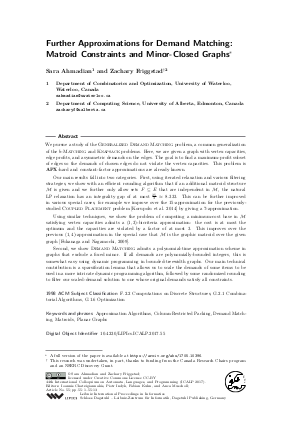Further Approximations for Demand Matching: Matroid Constraints and Minor-Closed Graphs
Authors Sara Ahmadian, Zachary Friggstad
-
Part of:
Volume:
44th International Colloquium on Automata, Languages, and Programming (ICALP 2017)
Part of: Series: Leibniz International Proceedings in Informatics (LIPIcs)
Part of: Conference: International Colloquium on Automata, Languages, and Programming (ICALP) - License:
 Creative Commons Attribution 3.0 Unported license
Creative Commons Attribution 3.0 Unported license
- Publication Date: 2017-07-07
File

PDF
LIPIcs.ICALP.2017.55.pdf
- Filesize: 0.64 MB
- 13 pages
Document Identifiers
Subject Classification
Keywords
- Approximation Algorithms
- Column-Restricted Packing
- Demand Matching
- Matroids
- Planar Graphs
Metrics
- Access Statistics
-
Total Accesses (updated on a weekly basis)
0Document
0Metadata
Abstract
We pursue a study of the Generalized Demand Matching problem, a common generalization of the b-Matching and Knapsack problems. Here, we are given a graph with vertex capacities, edge profits, and asymmetric demands on the edges. The goal is to find a maximum-profit subset of edges so the demands of chosen edges do not violate the vertex capacities. This problem is APX-hard and constant-factor approximations are already known. Our main results fall into two categories. First, using iterated relaxation and various filtering strategies, we show with an efficient rounding algorithm that if an additional matroid structure M is given and we further only allow sets that are independent in M, the natural LP relaxation has an integrality gap of at most 25/3. This can be further improved in various special cases, for example we improve over the 15-approximation for the previously- studied Coupled Placement problem [Korupolu et al. 2014] by giving a 7-approximation. Using similar techniques, we show the problem of computing a minimum-cost base in M satisfying vertex capacities admits a (1,3)-bicriteria approximation: the cost is at most the optimum and the capacities are violated by a factor of at most 3. This improves over the previous (1,4)-approximation in the special case that M is the graphic matroid over the given graph [Fukanaga and Nagamochi, 2009]. Second, we show Demand Matching admits a polynomial-time approximation scheme in graphs that exclude a fixed minor. If all demands are polynomially-bounded integers, this is somewhat easy using dynamic programming in bounded-treewidth graphs. Our main technical contribution is a sparsification lemma that allows us to scale the demands of some items to be used in a more intricate dynamic programming algorithm, followed by some randomized rounding to filter our scaled-demand solution to one whose original demands satisfy all constraints.
Cite As Get BibTex
Sara Ahmadian and Zachary Friggstad. Further Approximations for Demand Matching: Matroid Constraints and Minor-Closed Graphs. In 44th International Colloquium on Automata, Languages, and Programming (ICALP 2017). Leibniz International Proceedings in Informatics (LIPIcs), Volume 80, pp. 55:1-55:13, Schloss Dagstuhl – Leibniz-Zentrum für Informatik (2017)
https://doi.org/10.4230/LIPIcs.ICALP.2017.55
BibTex
@InProceedings{ahmadian_et_al:LIPIcs.ICALP.2017.55,
author = {Ahmadian, Sara and Friggstad, Zachary},
title = {{Further Approximations for Demand Matching: Matroid Constraints and Minor-Closed Graphs}},
booktitle = {44th International Colloquium on Automata, Languages, and Programming (ICALP 2017)},
pages = {55:1--55:13},
series = {Leibniz International Proceedings in Informatics (LIPIcs)},
ISBN = {978-3-95977-041-5},
ISSN = {1868-8969},
year = {2017},
volume = {80},
editor = {Chatzigiannakis, Ioannis and Indyk, Piotr and Kuhn, Fabian and Muscholl, Anca},
publisher = {Schloss Dagstuhl -- Leibniz-Zentrum f{\"u}r Informatik},
address = {Dagstuhl, Germany},
URL = {https://drops.dagstuhl.de/entities/document/10.4230/LIPIcs.ICALP.2017.55},
URN = {urn:nbn:de:0030-drops-74600},
doi = {10.4230/LIPIcs.ICALP.2017.55},
annote = {Keywords: Approximation Algorithms, Column-Restricted Packing, Demand Matching, Matroids, Planar Graphs}
}
Author Details
References
-
Aris Anagnostopoulos, Fabrizio Grandoni, Stefano Leonardi, and Andreas Wiese. A mazing 2+ε approximation for unsplittable flow on a path. In Proceedings of the Twenty-fifth Annual ACM-SIAM Symposium on Discrete Algorithms, pages 26-41. Society for Industrial and Applied Mathematics, 2014.

-
Nikhil Bansal, Nitish Korula, Viswanath Nagarajan, and Aravind Srinivasan. Solving packing integer programs via randomized rounding with alterations. Theory of Computing, 8(1):533-565, 2012.

-
Gruia Calinescu, Amit Chakrabarti, Howard Karloff, and Yuval Rabani. An improved approximation algorithm for resource allocation. ACM Transactions on Algorithms, 7, 2011.

-
Erik D. Demaine, Mohammad Taghi Hajiaghayi, and Ken-ichi Kawarabayashi. Algorithmic graph minor theory: Decomposition, approximation, and coloring. In Proceedings of the Forty-sixth Annual IEEE Symposium on Foundations of Computer Science, pages 637-646. IEEE, 2005.

-
Takuro Fukunaga and Hiroshi Nagamochi. Network design with weighted degree constraints. Discrete Optimization, 7(4):246-255, 2010.

-
Georgii Gens and Evgenii Levner. Complexity of approximation algorithms for combinatorial problems: a survey. ACM SIGACT News, 12(3):52-65, 1980.

-
Mohammad Ghodsi, Hamid Mahini, Kian Mirjalali, Shayan Oveis Gharan, Morteza Zadimoghaddam, et al. Spanning trees with minimum weighted degrees. Information Processing Letters, 104(3):113-116, 2007.

-
Johan Håstad. Clique is hard to approximate within n^1-ε. Acta Mathematica, 182(1):105-142, 1999.

-
Madhukar Korupolu, Adam Meyerson, Rajmohan Rajaraman, and Brian Tagiku. Coupled and k-sided placements: generalizing generalized assignment. Mathematical Programming, 154(1-2):493-514, 2015.

-
Lap Chi Lau, Ramamoorthi Ravi, and Mohit Singh. Iterative methods in combinatorial optimization, volume 46. Cambridge University Press, 2011.

-
Michael J. Magazine and Maw-Sheng Chern. A note on approximation schemes for multidimensional knapsack problems. Mathematics of Operations Research, 9(2):244-247, 1984.

-
Michael Mitzenmacher and Eli Upfal. Probability and computing: Randomized algorithms and probabilistic analysis. Cambridge University Press, 2005.

-
Ojas Parekh. Iterative packing for demand and hypergraph matching. In International Conference on Integer Programming and Combinatorial Optimization, pages 349-361. Springer, 2011.

-
Alexander Schrijver. Combinatorial Optimization: Polyhedra and Efficiency. Springer, 2003.

-
Bruce Shepherd and Adrian Vetta. The demand-matching problem. Mathematics of Operations Research, 32(3):563-578, 2007.

-
Mohit Singh and Lap Chi Lau. Approximating minimum bounded degree spanning trees to within one of optimal. In Proceedings of the Thirty-eighth Annual ACM Symposium on Theory of Computing, pages 661-670. ACM, 2007.

- Mohit Singh and Hehui Wu. Nearly tight linear programming bounds for demand matching in bipartite graphs. http://cgi.cs.mcgill.ca/~hehui/paper/Demand_matching.pdf, 2012.
-
David Zuckerman. Linear degree extractors and the inapproximability of max clique and chromatic number. In Proceedings of the Thirty-eighth Annual ACM Symposium on Theory of Computing, pages 681-690. ACM, 2006.

